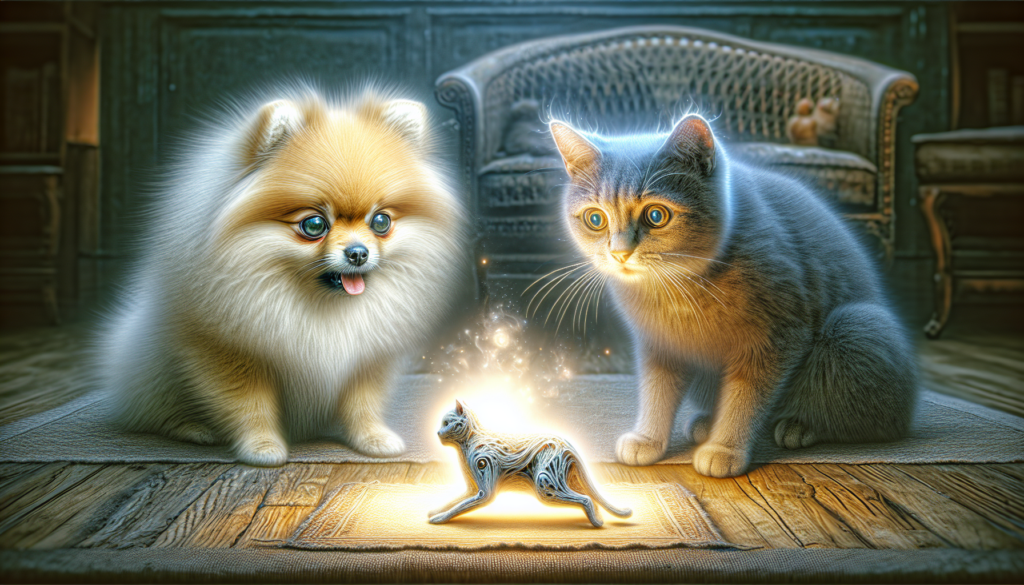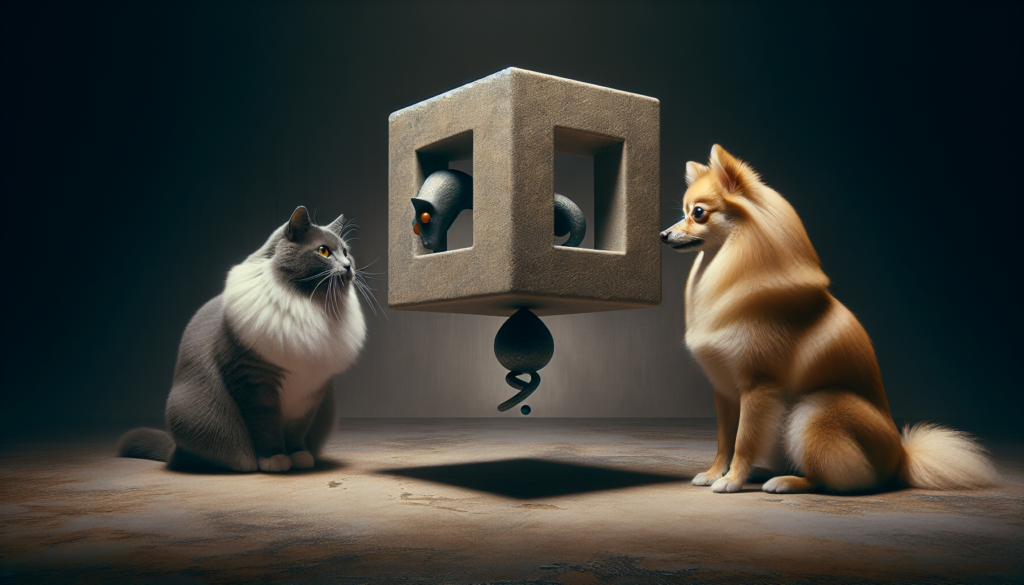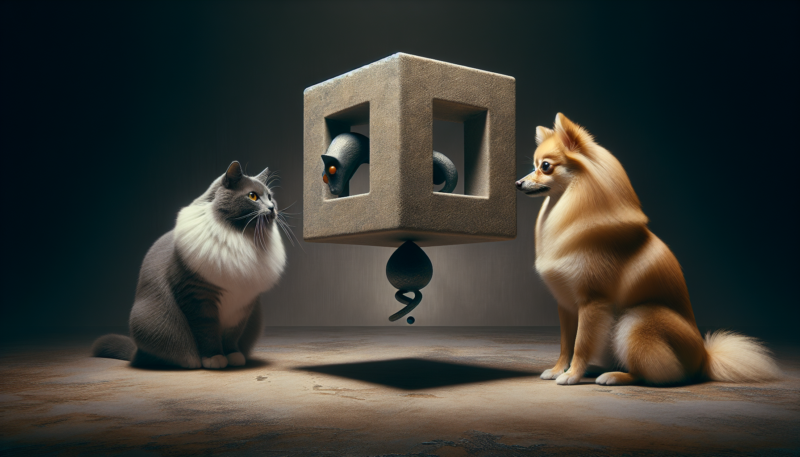Have you ever wondered if Pomeranians and cats can actually get along? Many pet owners often ponder this question when thinking of adding a furry friend to their family. Understanding the dynamics between these two adorable creatures is crucial in creating a harmonious environment at home. In this article, we will explore whether Pomeranians and cats can coexist peacefully, shedding light on their compatibility and offering tips to help foster a loving relationship between them.

Understanding Pomeranians and Cats
Pomeranians and cats have distinct characteristics that contribute to their individuality as pets. Understanding these traits will help create a harmonious environment when introducing these two animals into the same household.
Characteristics of Pomeranians
Pomeranians are small, fluffy dogs known for their vibrant personalities. They are energetic, intelligent, and love being the center of attention. Pomeranians tend to be confident and protective, making them excellent watchdogs. However, their small size can sometimes lead to them being a bit feisty or territorial.
Characteristics of Cats
Cats, on the other hand, have a reputation for their independence and mysterious nature. They are known for their agility, grace, and ability to jump to impressive heights. Cats can be affectionate and loving, but they also value their personal space and have a strong sense of territory. They may display a range of behaviors, from being curious and playful to aloof and unpredictable.
Introducing Pomeranians and Cats
Introducing Pomeranians and cats requires careful planning and consideration to ensure a positive and safe environment for both pets.
Preparing for the Introduction
Before the actual introduction takes place, it is crucial to prepare the space and environment. Create separate spaces for each pet, complete with their own food bowls, litter boxes, and sleeping areas. This will allow them to feel secure and have their personal space, reducing the likelihood of conflicts.
Supervised Interactions
When it’s time for the initial meeting, always supervise the interactions between your Pomeranian and cat. Keep the Pomeranian on a leash and allow the cat to have an escape route. This way, you can intervene if any signs of aggression or discomfort arise. It’s important to prioritize the safety and well-being of both animals during this process.
Positive Reinforcement
Positive reinforcement is a key component in building a positive relationship between your Pomeranian and cat. Reward both pets with treats, praises, and petting when they display calm and friendly behavior towards each other. This will help them associate their interactions with positive experiences and strengthen their bond over time.
Providing Separate Spaces
Even when your Pomeranian and cat have formed a positive relationship, it is essential to continue providing them with separate spaces. This will allow each pet to have their alone time and ensure they feel secure and comfortable. Having designated areas for each pet also helps prevent territorial disputes and reduces stress.
Building a Positive Relationship
A positive relationship between your Pomeranian and cat requires a gradual introduction, a safe environment, and slow, controlled interactions.
Gradual Introduction
Start by allowing your Pomeranian and cat to become familiar with each other’s scents. Swap bedding or use a cloth to rub each pet’s scent and place it in the other’s area. This will help them get used to each other’s presence without direct contact. Gradually introduce short and supervised face-to-face interactions, gradually increasing the time spent together as they become more comfortable.
Creating a Safe Environment
Ensure that your home provides a safe environment for both pets. Secure any openings or escape routes to prevent accidents or escape attempts. Remove any small objects or hazards that can be ingested or cause harm. By creating a safe environment, you’ll have peace of mind knowing that both your Pomeranian and cat are protected.
Neutral Spaces
Neutral spaces are essential to avoid territorial conflicts. Initially, introduce your Pomeranian and cat in a neutral space, such as a separate room or a fenced-off area. This eliminates any existing territorial boundaries and prevents either pet from feeling threatened. Gradually, allow them to explore shared spaces under supervision and progressively expand their access to each other’s areas.
Familiar Scents
Introducing familiar scents can help ease the transition for both your Pomeranian and cat. Rub a towel or blanket on one pet and place it in the other’s space. This will allow them to become familiar with each other’s scent, which can help in creating a sense of comfort and familiarity. Familiar scents can also be used during supervised interactions to promote positive associations and reduce anxiety.
Slow and Controlled Interactions
Ensure all interactions between your Pomeranian and cat are slow and controlled. Avoid sudden movements or loud noises that may startle either pet. Allow them to approach each other at their own pace, using positive reinforcement and treats to reward calm behavior. As they grow more comfortable, gradually increase the duration and proximity of their interactions while closely monitoring their behavior.
Common Challenges and How to Overcome Them
While Pomeranians and cats can develop a positive relationship, some challenges may arise. Understanding and addressing these challenges is crucial for a harmonious coexistence.
Territorial Behavior
Both Pomeranians and cats can exhibit territorial behavior, which may lead to conflicts. To address this, ensure that each pet has its own designated areas, and monitor their behavior closely for any signs of territorial aggression. Implement positive reinforcement and create a peaceful environment to discourage territorial disputes and foster a sense of shared territory.
Resource Guarding
Resource guarding, where a pet becomes possessive over food, toys, or attention, can occur in both Pomeranians and cats. It is important to establish boundaries and provide separate resources for each pet to avoid conflicts. Additionally, practice positive reinforcement training to discourage resource guarding behavior and promote sharing and cooperation.
Predatory Instincts
Pomeranians and cats have inherent predatory instincts, which can sometimes lead to chasing or aggression. To prevent accidents or harm, always supervise interactions and redirect their attention onto appropriate toys or activities. Utilize positive reinforcement training to reinforce desirable behavior and redirect any predatory instincts towards alternative outlets, such as interactive toys or games.
Dealing with Aggression
If aggression occurs during interactions between your Pomeranian and cat, it is important to intervene immediately and separate them. Consult with a professional animal behaviorist to assess the situation and provide guidance on managing and addressing the aggression. Remember, keeping both pets safe and maintaining a harmonious environment should always be the priority.

Training and Socialization
Proper training and socialization are essential for both your Pomeranian and cat to establish a well-behaved and socially adept household.
Early Socialization
Socializing your Pomeranian and cat from a young age is crucial for their development and ability to interact positively with each other and other animals. Expose them to various environments, people, and animals in a controlled and positive manner. This will help them become comfortable with new experiences and reduce the likelihood of fear or aggression.
Positive Reinforcement Training
Positive reinforcement training is an effective and humane method of teaching desired behaviors to both Pomeranians and cats. Use treats, praises, and rewards to reinforce behaviors like sitting, staying, and coming when called. Positive reinforcement training can enhance their obedience and responsiveness, making interactions between the two pets more manageable.
Obedience Commands
Teaching obedience commands to both your Pomeranian and cat can provide structure and boundaries in their interactions. Consistently practice basic commands such as sit, stay, and leave it to establish clear expectations. This will help prevent conflicts and allow for easier supervision during their interactions.
Establishing Boundaries
Establishing boundaries is vital in maintaining a peaceful coexistence between your Pomeranian and cat. Use baby gates or physical barriers to restrict access to certain areas if needed. Encourage respect for personal spaces by providing separate sleeping areas and discourage intrusive behavior. By setting clear boundaries, both pets will feel secure and understand their respective territories.
Behavioral Training
Alongside obedience training, consider behavioral training for both your Pomeranian and cat. This can address specific issues, such as excessive barking or scratching furniture. Seek guidance from a professional trainer or behaviorist who can provide tailored strategies to modify and correct unwanted behaviors. By addressing any behavioral concerns, you’ll be better equipped to facilitate a positive relationship between your pets.
Understanding Body Language
Understanding the body language of both Pomeranians and cats is essential in recognizing their emotions, stress levels, and potential conflicts.
Pomeranian Body Language
Pomeranians communicate their feelings through various body language cues. When feeling relaxed and content, they may wag their tail, have relaxed ears, and maintain open body posture. Conversely, signs of stress or discomfort can include excessive barking, raised hackles, and avoidance behaviors. Observing and interpreting these signals accurately will help you understand when your Pomeranian is comfortable or requires intervention.
Cat Body Language
Cats also have distinct body language cues that convey their emotions and intentions. Relaxed and content cats typically exhibit soft, half-closed eyes, a calm tail posture, and ears forward or slightly to the side. When feeling threatened or defensive, they may flatten their ears, arch their back, and hiss or growl. Familiarizing yourself with these subtle cues will enable you to better interpret your cat’s behavior and respond accordingly.
Recognizing Signs of Stress
Both Pomeranians and cats can experience stress in new or challenging situations. Signs of stress can include excessive panting, pacing, restlessness, or withdrawal. If you notice these signs, it’s important to provide a calm and secure environment, allowing both pets to adjust at their own pace and seeking professional advice if needed.
Signs of Fear or Aggression
Fear or aggression can occasionally arise during interactions between Pomeranians and cats. Signs of fear can include cowering, trembling, or attempts to hide. Aggression can be displayed through growling, hissing, or biting. If you observe any signs of fear or aggression, intervene immediately and ensure the safety and well-being of both pets. Consulting with an animal behaviorist can provide valuable guidance in addressing and managing these behaviors.
Benefits of Having Both
Having both a Pomeranian and a cat in your household can offer numerous benefits beyond companionship.
Companionship and Play
Pomeranians and cats can provide each other with companionship and play. They may engage in chase games, play-fighting, or cuddling together. Their interactions can bring joy and entertainment to both pets and foster a sense of camaraderie.
Improved Mental Stimulation
The presence of both a Pomeranian and a cat can contribute to improved mental stimulation for both pets. They can engage in interactive play, which helps exercise their cognitive abilities and prevents boredom. Mental stimulation is essential for the overall well-being and happiness of your furry friends.
Socializing Opportunities
Having both a Pomeranian and a cat in your household creates opportunities for socialization. Both pets can become accustomed to coexisting with different species, making it easier for them to interact with other animals outside the home. This socialization can lead to a more well-rounded and socially adept pet.
Emotional Support
Pets provide us with unconditional love and emotional support, and having both a Pomeranian and a cat can amplify this. They offer companionship during both joyful moments and challenging times. Your Pomeranian and cat will each bring their unique qualities to create a loving and supportive environment.
Supervising Interactions
Even with a positive relationship in place, it is crucial to continue supervising interactions between your Pomeranian and cat.
Creating a Peaceful Environment
Maintain a peaceful environment by minimizing any potential stressors that may trigger conflicts. Keep noise levels low and provide hiding spots for both pets. Consider using calming aids, such as pheromone diffusers or natural remedies, to promote a peaceful atmosphere during their interactions.
Setting up Boundaries
Clearly establish and maintain boundaries to prevent undesirable behaviors or conflicts. Use baby gates or closed doors to restrict access to certain areas if necessary. This ensures that both your Pomeranian and cat have their respective spaces and feel secure.
Ignoring Negative Behavior
If either your Pomeranian or cat displays negative behavior during their interactions, avoid scolding or punishing them. Instead, ignore the negative behavior and redirect their focus onto something positive. Reward and reinforce desirable behavior, guiding them towards more appropriate actions.
Redirecting Behavior
Redirecting behavior is a valuable technique to manage and prevent conflicts. If you notice escalating tension or signs of potential aggression, distract both pets with an engaging activity or redirect their attention onto separate toys or treats. By redirecting their focus onto positive outlets, you can ease any potential tensions and maintain a peaceful environment.
Considerations Before Getting a Pomeranian and a Cat Together
Before deciding to bring a Pomeranian and a cat into the same household, consider several factors that can impact their compatibility and coexistence.
Individual Personalities
Both Pomeranians and cats have individual personalities, which can significantly influence how they interact with each other. Some Pomeranians may be more tolerant and friendly towards cats, while others may exhibit more assertive or territorial tendencies. Similarly, each cat will have its own disposition and preferences. Consider the temperaments of both pets before making a decision.
Age and Energy Levels
The age and energy levels of both your Pomeranian and cat are crucial considerations for compatibility. A high-energy Pomeranian may overwhelm a senior or low-energy cat, leading to stress or tension. Likewise, an energetic cat may provoke or frustrate a young or elderly Pomeranian. Matching both pets’ energy levels and considering their age-related needs will facilitate a more harmonious living arrangement.
Breed and Cat Compatibility
Not all dog breeds are suitable for coexisting with cats, and the same applies to Pomeranians. Some dog breeds have a stronger prey drive or territorial instincts, which can pose challenges when living with cats. Research Pomeranian breed characteristics and ensure the temperament of the specific individual you’re considering. It’s also important to consult with breeders or shelters for any information on their Pomeranian’s prior experiences or history with cats.
Conclusion
With proper understanding, careful introduction, and ongoing supervision, Pomeranians and cats can develop a positive and harmonious relationship. Respect for each pet’s individual characteristics, needs, and boundaries is crucial in fostering a peaceful coexistence. By creating a safe and controlled environment, utilizing positive reinforcement, and addressing any challenges that arise, you can maximize the potential for a loving and enjoyable companionship between your Pomeranian and cat.
